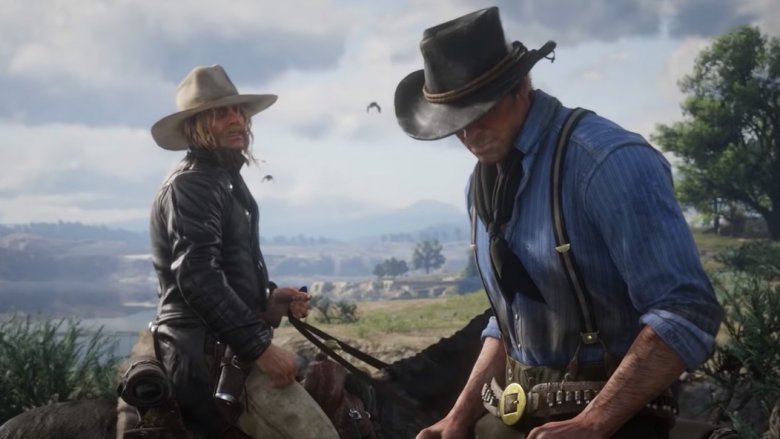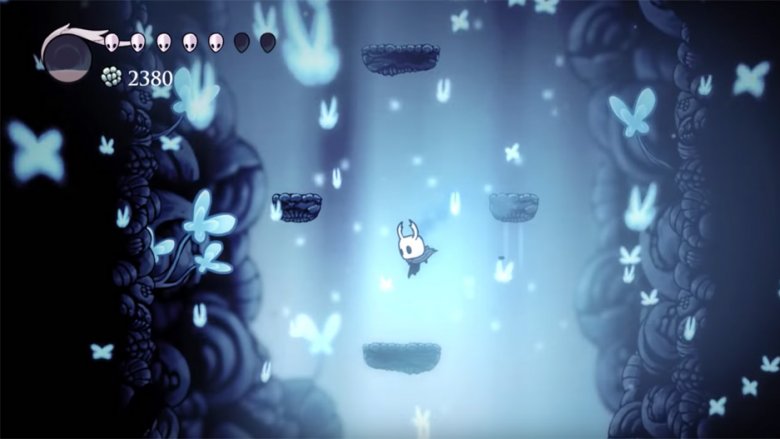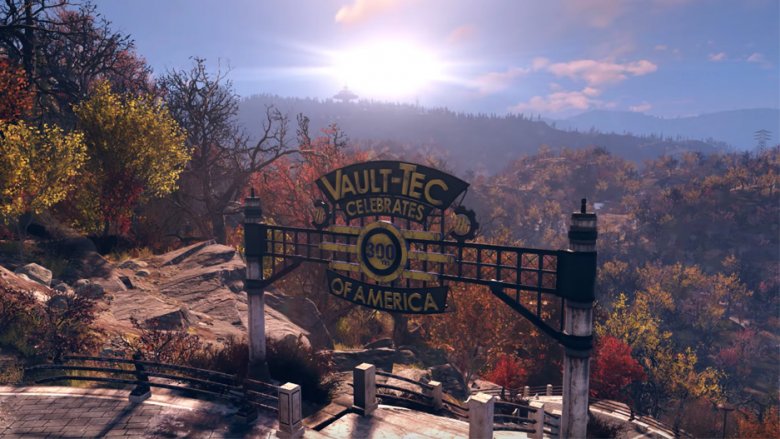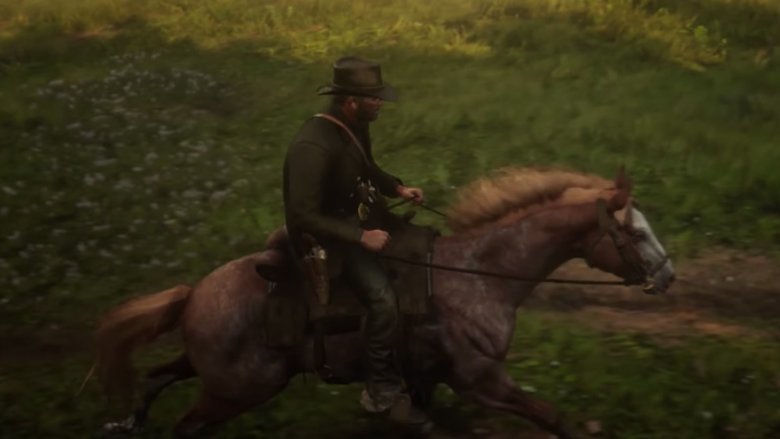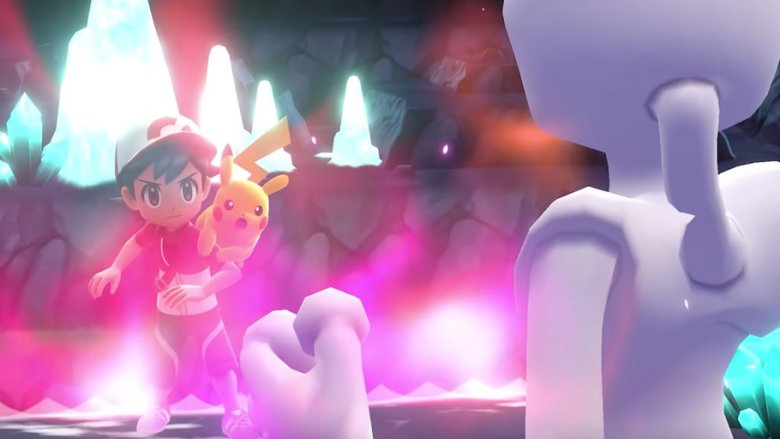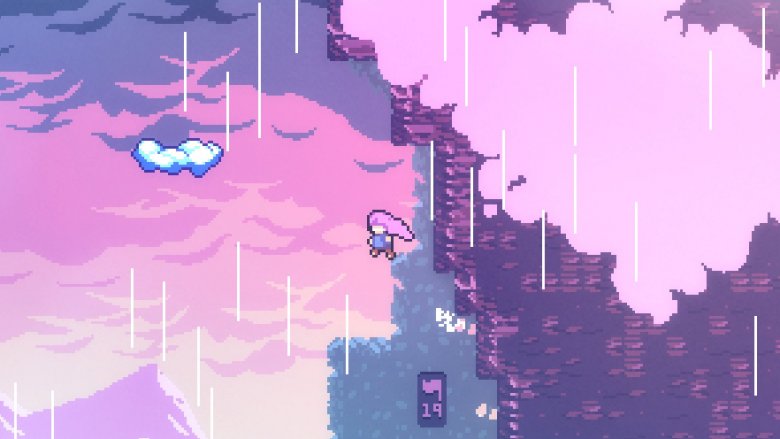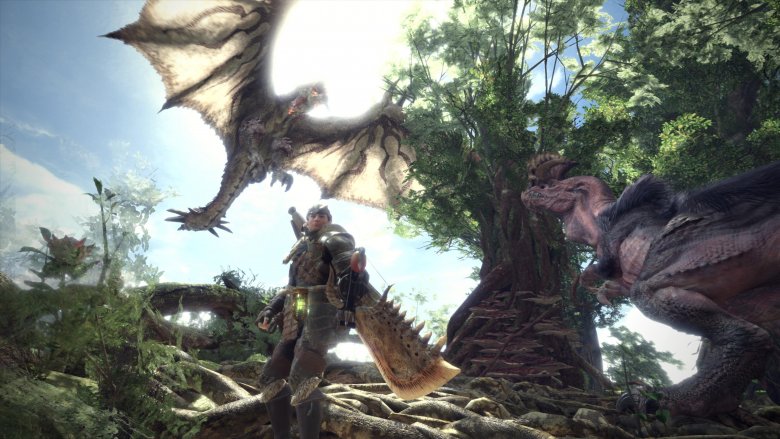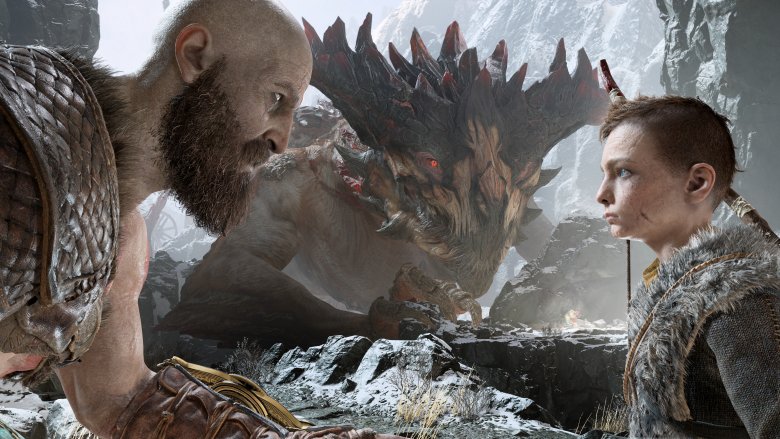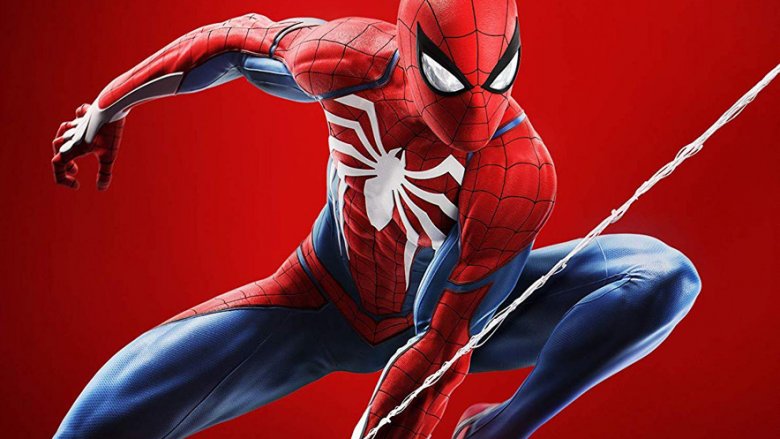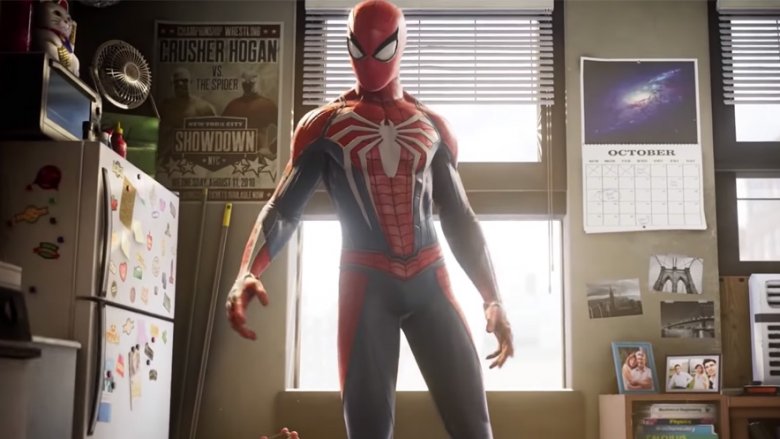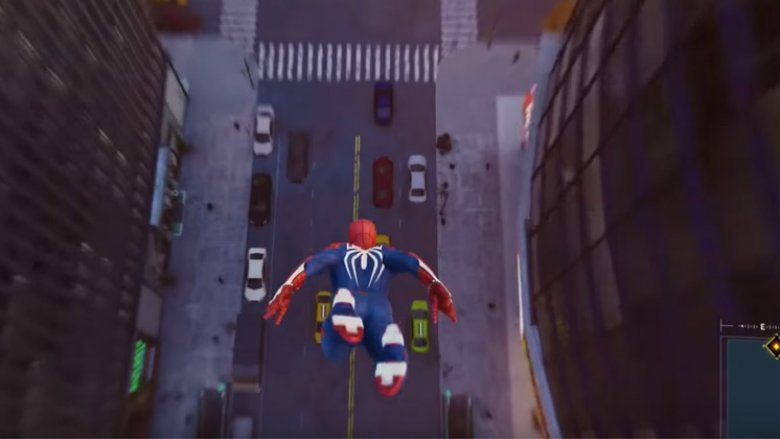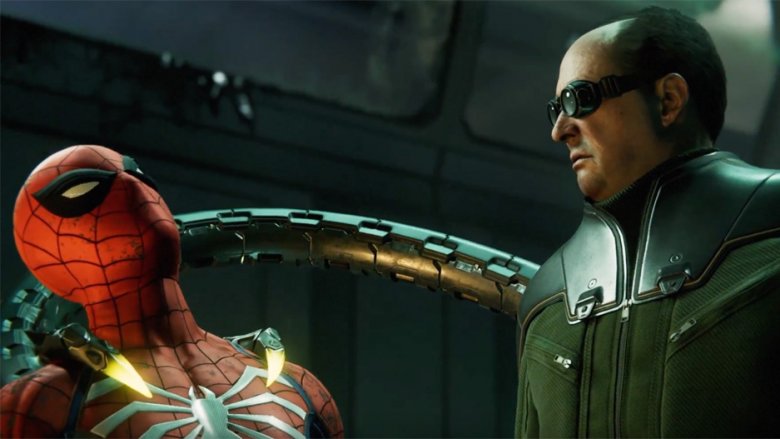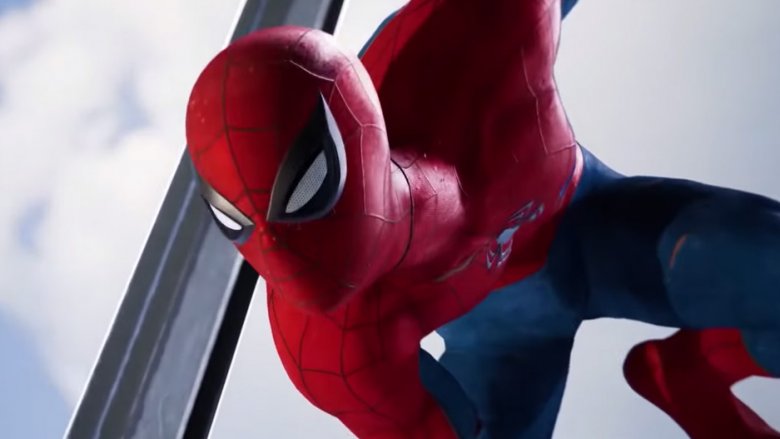The Best Video Game Of 2018 Is Not What You Think
2018 was a truly incredible year for video games. With fresh installments of hit franchises, brand new epics, and an explosion of fantastic indie games (not to mention the continued dominance of past years' hits like Overwatch and Fortnite), there was no shortage of great titles vying for your attention. As tough as it might be on our wallets, that kind of embarrassment of riches makes for a pretty good time for gamers... until it comes time to decide which one is actually the best.
With so many great games released this year, the debate about which one reigns supreme is bound to rage well into 2019. For us, however, everything's finally been settled. We've taken a close look at the many highlights and put careful consideration into how best to compare them. Now, we've got our definitive choice for the single best video game of 2018 — and it might not be the one you'd expect.
Defining the best
Before we really dive into it, it's worth a reminder that "the best" is a pretty subjective term, and even if it wasn't such a tough choice, our pick is bound to be at least a little controversial. That's why it's important to define our criteria right up front.
The reasoning here is pretty simple: how well did the game do what it set out to do, and how fun was that overall experience? Whether it's an indie title or a triple-A hit, whether it's innovating something brand new or iterating on the established mechanics of a long-running franchise, the most important factor in any video game is how enjoyable it is to get through whatever it presents. It's why a relatively simple game like Hollow Knight — which was technically a 2017 release, even if it hit most platforms this year — can provide an experience that stacks up against a complex and expansive title like The Legend of Zelda: Breath of the Wild.
The controls, the difficulty, and even the aesthetics all contribute to those things, and each one of those aspects can produce a critical flaw that can make an otherwise perfect game into something that's just merely great. So before we get to our pick for the best, let's talk about the ones that didn't make it.
Fallout falls short
From the moment it was announced, Fallout 76 was already in the running to be the game of the year. The newest version of the long-running post-apocalyptic franchise shifted the single-player experience of exploring a vast, post-nuclear wasteland with a rich lore and compelling NPCs into an online multiplayer game that, ironically, crafted an incredible sense of loneliness and isolation.
In a lot of ways, 76 was the product of bits and pieces that had been experimented with throughout the history of the Fallout franchise. Placing players in the role of a vault-dweller tasked with reclaiming Appalachia 25 years after nuclear Armageddon, it incorporated the settlement-building of Fallout 4, the survival mechanics of New Vegas' "Hardcore" mode, and even took plot cues from the original Fallout. That alone makes it refreshing — it takes the series back to a time when survival was still a difficult task, before factions like the NCR, the Brotherhood of Steel, and Caesar's Legion had reformed a version of civilization themselves. Throw in the Scorched, some Appalachian cryptids, and the eerie, depopulated wasteland of West Virginia, and you've got a truly compelling take on a franchise that's been running for decades. If nothing else, it's the game that proved that, as Polygon said, Fallout has become a genre unto itself.
Unfortunately, 76 also has a lot of the problems that can be seen in, well, every other Bethesda game. While the environment is compelling, a lot of the early quests — particularly in the first few hours — feel more like doing chores than exploration. It's not just fetch quests, either; there are a few that are literally built around in-game obstacle courses that reward you with a new hat. The transition of established Fallout game mechanics from single-player epic to online multiplayer is also not perfect. With a few patches and some tweaking, 76 will undoubtedly keep providing a super rewarding experience, but for now, it'll have to settle for just being great.
Red Dead Rejection
Another odds-on favorite pick for Best of the Year is Rockstar's Red Dead Redemption 2, and make no mistake: it is a towering achievement in game design. A prequel story is always a risky venture — especially when we've already seen how Arthur Morgan's story ends back in the first installment — but this game provides players with what might be Rockstar's best narrative ever.
It's also a remarkably thorough game, with a depth to its design that's truly staggering. Players aren't just taking Arthur from one gunfight to the next, they're keeping him fed and bathed, maintaining his equipment, interacting with NPCs who seem to remember him from one encounter to the next, and more. It's become the shorthand joke for how in-depth this game is, but the fact that there's a dedicated button for brushing your horse, and that you're expected and encouraged to use it often, really does say it all. Add in a sprawling, beautiful representation of the Old West that was full of cities with their own character and mysterious environments that gave you just enough information to make you desperate to know more, and RDR2 brings an unmatched level of craft to the table.
But in the end, this might be a case of more being just a little bit less. As a lot of reviews have pointed out, those deep and detailed systems are, as Kotaku put it, "exuberantly unfun." It's building on the trend towards "realism" that Rockstar began with Grand Theft Auto 4, and the result is that even traversing that beautiful map they've given you can quickly turn into a frustrating exercise in wrangling your horse. If that's your thing, more power to you, but at some point, having to feed and bathe your digital avatar just so you can get dumped off a horse into the mud becomes something we could just go outside and do.
Pokémon: Let's Go (to another game)
The other game marking a major franchise's return to consoles in 2018 was, of course, Pokémon: Let's Go, which came to the Nintendo Switch in both Pikachu and Eevee versions. It's less worth mentioning because it's a good game (although it is) and more because it just happens to be the latest major release of a beloved worldwide phenomenon.
What's surprising, though, is how much of a departure it is from previous entries. It's essentially a remake of Pokémon Yellow, and while it definitely benefits from 20 years of further development, it's a step away from the complexities of recent Pokémon games like Sun and Moon. That make sense, since it's meant to be a bridge between the core games and the wildly popular Pokémon Go mobile game (hence the title), but that requires massive changes.
The most notable one, of course, is the removal of battles with wild Pokémon in favor of just lobbing Pokéballs at them until they're caught or run away. That's a massive change to the core mechanic of the games, and while that's not necessarily a bad thing, it's pretty jarring. For players who have been waiting years for a full-on console Pokémon game, there are a lot of areas where it's hard not to see Let's Go as a huge step backwards, even if it does remain incredibly fun and delightful.
Celeste and the mountain of depression
Anyone looking for an offbeat indie pick for game of the year would find an obvious choice in Celeste, a puzzle platformer from Matt Thorson and Noel Berry that was released back in January. Compared to big-name releases like the ones we've already discussed, it's a dark horse pick for 2018's best, but has a legitimate claim as an experience that excels at every single thing it attempts.
The mechanics are solid, allowing the main character, Madeline, to interact with her environment in a simple way that, thanks to a constantly changing series of obstacles, never gets boring. It's straightforward, but there are tricky pieces and optional bits that are reminiscent of Fez. The puzzles hit that beautiful sweet spot of difficulty where it's just challenging enough to be tricky without being so mind-bendingly difficult that you're driven to rage-quit. In terms of gameplay, it's one of the best recent examples of teaching the player as they go, giving you everything you need to conquer its puzzles without spending time holding your hand. It is, however, incredibly accessible — it even includes settings that give you granular control over the difficulty which, while anathema to purists, makes it easy for everyone to experience the story.
And that story is where Celeste really shines. At this point, it's a cliche for an indie game to combine pixel graphics with heavy, emotional themes, something that can easily come off as twee or pretentious. Celeste, however, offers up an exploration of depression and anxiety through the medium of a relentlessly lethal puzzle platformer in a way that blends theme and mechanics almost perfectly, and handles its emotional content as well as any of its triple-A cousins. It's absolutely essential, but it's not the best.
The grind brings Monster Hunter: World down to Earth
It's hard to say why it took Monster Hunter so long to catch on in the West, but we're glad it did. The series seems tailor-made to be a global hit. Its core gameplay loop — you hunt beasts and score better gear, which allows you to to hunt bigger beasts and get even better gear — is the same cycle that's propelled franchises like Destiny and Diablo to international superstardom. It has one of the most satisfying cooperative multiplayer experiences available, and its combat requires Souls-like precision and planning.
Monster Hunter hasn't ever been overly accessible, however — at least, not until now. Monster Hunter: World may not be as complex as previous entries in the series, but its streamlined approach to tracking, hunting, and crafting is explicitly designed to appeal to as wide an audience as possible, and it works beautifully. If you like RPGs and you've always wanted to give this Monster Hunter thing a try, Monster Hunter: World is hands-down the best way to get started.
Monster Hunter: World is undoubtedly the biggest RPG of the year, and if it gets its hooks into you, it's the only game from 2018 you'll need. Unfortunately, for the rest of us, the repetition gets old before too long. Ultimately, the game doesn't have enough endgame content to keep casual fans occupied, and the constant grind is just tedious enough to keep Monster Hunter: World out of 2018's top spot.
God of War is close to divine, but not quite
Heads-up, old-school PlayStation fans: This ain't your daddy's God of War. Campy hack-n-slash adventures stuffed full of spectacle and smothered in a thick layer of machismo might've fit in back in 2005, when the original God of War hit the PS2, but times have changed and so has PlayStation. These days, Sony's consoles are best known for intricate narrative adventures like The Last of Us, Uncharted, and Horizon: Zero Dawn. Those games are full of blockbuster moments, but they've got depth, too. So, Sony's Santa Monica studio gave God of War a makeover. It couldn't have gone better.
Everything that made God of War special is still here, of course. As Kratos, you're still battling against all kinds of demons and deities — Norse this time, not Greek — in fast-paced action scenes that'll leave you gasping for breath. The world is still gorgeous and cinematic, right down to a camera that replicates the single-shot fad that's taking TV by storm. And yet, in 2018, that's not all God of War has to offer. Its story, which focuses on Kratos' relationship with his son, Arteus, has actual heart. With the addition of Kratos' Leviathan Axe, combat transforms from a mash-fest into something more strategic.
That's God of War in a nutshell: Everything you loved before, but more thoughtful and nuanced. It's a must-play game, and more than one outlet has crowned God of War game of the year. It's hard to argue with them, and yet...
And the winner is…
Up to now, we've been talking about games that excel in specific areas: well-realized worlds, compelling stories, progressive game design, and, most importantly, fun. Taking all of those elements into account, there's one great game that excels in every area: Insomniac and Sony's PlayStation 4 Spider-Man.
As much as it might not be the expected choice, it also shouldn't come as a surprise. While there were a couple of missteps in the early days of 8- and 16-bit systems, there hasn't really been a bad Spider-Man game since Neversoft dropped the first 3D Spidey adventure back in the Dreamcast era. Even the weird ones, like the one about all the interdimensional Spiders-Men or the one that's basically about Spidey fighting an army of Venomized zombies in a virtually apocalyptic Manhattan, are still pretty fun.
A great deal of that has to do with how Spider-Man works as a character. He's uniquely built for an urban environment that's easy to translate into the kind of 3D setting common to open world games, with super-powers that allow him to add the kind of effortless vertical element that games like the Assassin's Creed franchise have built themselves around. But that said, everything that those games have done well in the past is done immeasurably better in the PS4 Spider-Man — and that's only the beginning of its strengths.
It makes you feel like Spider-Man
One of the key marks of a great game is immersion — how well the game connects you to the world that it's creating. There's a massive roster of fantastic games that do this well. It's one of the reasons Fallout 76's emphasis on isolation is so important, because you as a player feel the same sense of desolation and loneliness that your character is feeling. It's why it's so rewarding to have your choices feel like they matter in Mass Effect, and why Silent Hills PT was so affecting.
It's also why so many reviews of Spider-Man point to one seemingly simple element that makes it so good: it makes you feel like Spider-Man. Again, part of that is down to the source material. Spidey's the perfect superhero for the mechanics of a video game: he's strong enough to, say, lift a car, but he's also been consistently portrayed as a hero who struggles. He's powerful and vulnerable in equal measure, and his reliance on technology like web-shooters lends itself seamlessly to skill trees and upgrades. On a purely mechanical level, it's why there have been so many great Spider-Man games and zero good games about Superman, a character whose powers are so virtually limitless that traditional video game challenges feel awkward at best and frustratingly pointless at worst.
Not coincidentally, that's the same reason that Spider-Man's approach to its title character is so reminiscent of Rocksteady's Arkham games. The key element in those was that more than anything else, they absolutely excelled at making you feel like Batman, terrifying crooks from the shadows before dropping into brutal fight scenes where you could effortlessly wreck five or six henchmen at a time. It's fair to say that Spider-Man takes more than a few cues from Arkham — the combat, for instance, is so similar that it can actually be pretty distracting in the early game — but in doing so, it tailors the experience to fit its hero in a way that really works.
Web-Slinging Simulator 2018
For the best example of how well Spider-Man captures the feel of being Peter Parker, look no further than the mechanic that you'll be spending the most time with: web-swinging through Manhattan. It's the make-or-break element of a Spider-Man game, and a perfect example of a key element in any open-world game.
In a game like Spider-Man (or Red Dead, or Assassin's Creed: Origins, or Breath of the Wild, or any other game where a massive map is a key selling point), traversal is one of the most important elements. The moment that getting from place to place becomes a chore is the moment that the player is taken out of the game, but if that movement is done well, it can make something feel less like a series of distinct missions and more like a cohesive experience.
Spider-Man does that better than almost any other video game — not just this year, but ever. It's such a basic building block that you almost don't notice all of the different tricks and visual cues that have gone into refining it, but the result is that the most basic aspect of the game, the simple act of moving from one place to the next, is itself an incredibly enjoyable experience. It changes the way combat works, it allows for boss fights that exist in three dimensions where you can take on supervillains without ever touching the ground, and it encourages players to explore its Marvel Universe Manhattan from the streets to the skyscrapers without ever feeling like it's giving you another mandatory task. It says a lot that while fast travel exists in the game — and comes complete with great little cutscenes about Spider-Man riding the subway in full costume — it's never something you really want to use. The controls are so tight, so well-realized, that it makes just existing in this world a fun experience.
Sinister storytelling
Another well-done element of Spider-Man is the story, and again, the easiest comparison comes from Arkham. In the same way that those games took an approach to Batman that established him as someone who had already fought and formed relationships with most of the villains that you'd want to see him fight in a kind of "Greatest Hits" story, Spider-Man gives us a Peter Parker who's been at this for a while. Specifically, the game tells us that we're showing up eight years into Spidey's heroic career, and while he has mysteriously never fought some of his major villains before — including the Green Goblin — he's got plenty of history to build on. That allows the game to skip the hassle of doing an origin story for Spider-Man, someone that we're all pretty familiar with already, but still show another character developing into the person we know.
In this case, it's Doctor Octopus, which makes for a very compelling shift in narrative. We get to see this tragic fall as an outsider, and as an added bonus, we get the origin of the Sinister Six to boot. Even more impressively, the way that it's all weaved together through a story that encompasses the Kingpin, Mister Negative, and other Spider-Foes makes it feel like it's capturing the structure of a comic book.
The Superior Spider-Game
There are plenty of other aspects of 2018's Spider-Man that are worth noting. There's a huge amount of Marvel Universe Easter eggs, like a statue of Lockjaw on Wall Street. There are forced stealth sections that are done well enough that, for the most part, they actually feel like they're adding variety to the game instead of slowing it down into frustrating diversions. There's the fact that Spider-Man's dialogue sounds more strained when he's web-swinging than when he's standing still, a minor touch that'll blow your mind when you realize it. Even the choice of throwing in lesser-known villains like Screwball and Taskmaster for the side missions is great.
The short version, though, is this: every single thing that Spider-Man does, it does well. There's no fatal flaw in any aspect, which makes it the most consistently, thoroughly enjoyable game of the year. In our estimation, that makes it the best.
